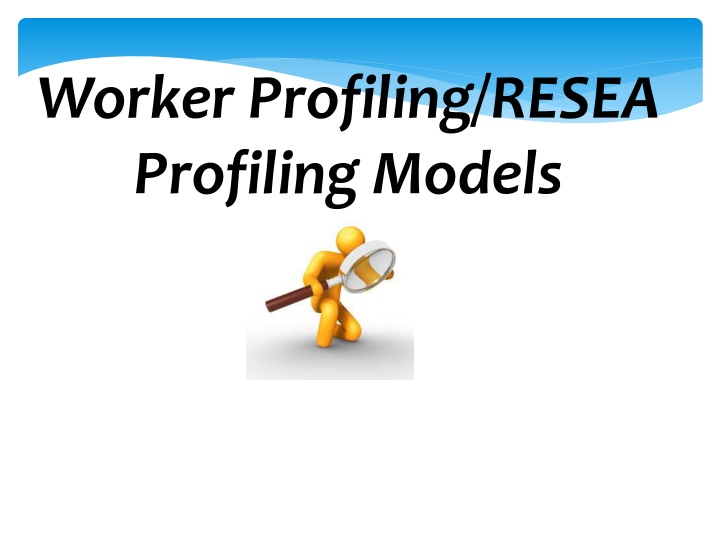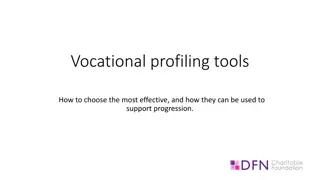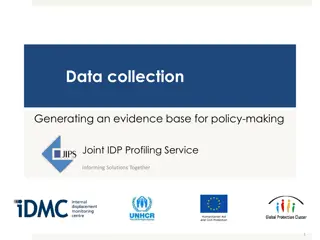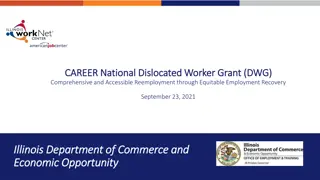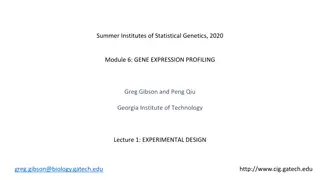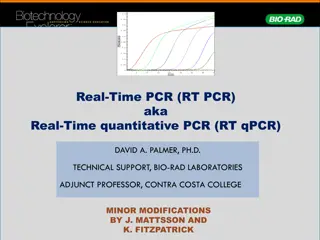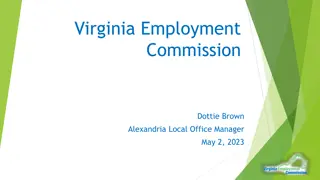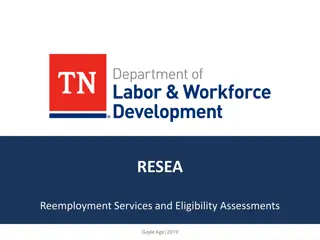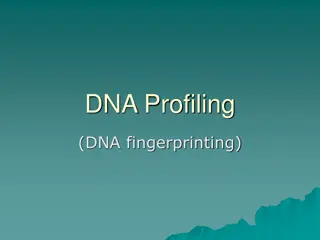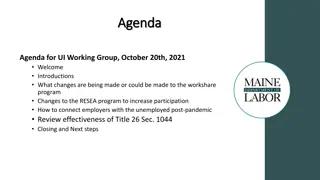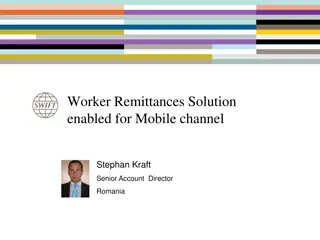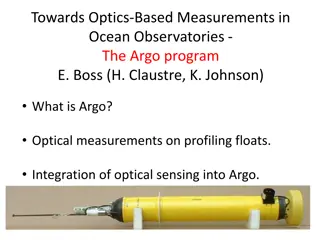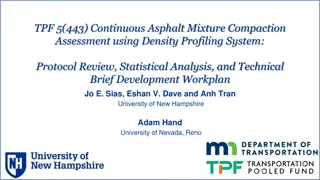RESEA Program in Worker Profiling and Reemployment Services
The RESEA program aids in assessing unemployment insurance eligibility and providing reemployment services to claimants. Profiling helps target those at risk of long-term unemployment. Coordination between UI and employment service providers is essential for effective state operations. New initial claimants and UCX claimants are profiled, excluding those on recall or union-affiliated. Various recommended variables play a role in the process.
Download Presentation

Please find below an Image/Link to download the presentation.
The content on the website is provided AS IS for your information and personal use only. It may not be sold, licensed, or shared on other websites without obtaining consent from the author.If you encounter any issues during the download, it is possible that the publisher has removed the file from their server.
You are allowed to download the files provided on this website for personal or commercial use, subject to the condition that they are used lawfully. All files are the property of their respective owners.
The content on the website is provided AS IS for your information and personal use only. It may not be sold, licensed, or shared on other websites without obtaining consent from the author.
E N D
Presentation Transcript
Worker Profiling/RESEA Profiling Models
WPRS to RESEA Enacted in 1993: Worker Profiling and Reemployment Services (WPRS) Public Law 103-152 Unemployment Compensation Amendments of 1993 Transition from REA to RESEA Began in 2015 Reemployment Eligibility Assessments and Reemployment Services (RESEA)
RESEA Program Goals Get Claimants into the American Job Centers to receive: UI Eligibility Assessments - ensure claimants meet initial and continuing UI eligibility requirements Reemployment Services - assist these claimants in their search for and return to work Profiling used to identify claimants that are most likely to become long-term unemployed/to exhaust UI benefits and need assistance returning to work
RESEA RESEA is designed to meet the needs of the targeted UI claimant population
Initial WPRS Models Initial Recommended/National Model Included: Recall Status (screen) Union Hiring Hall (screen) Education Job Tenure Change in Employment Previous Industry Change in Employment Previous Occupation Local Unemployment Rate
Other Recommended Variables Wage Replacement Rate Delay in Filing for Benefits (days/weeks) High Quarter Wage Rate Number of Base Period Employers Month of Year/Indicator for Season Severance or Vacation Pay More potential variables included in Tab 15
Profiling and State Operations Coordinate between UI and Employment Services Providers Balance Supply and Demand Service capacity limited by: Staff capacity & Funding
Who gets Profiled? New initial claimants that receive a first payment RESEA provides services to ALL UCX claimants UCX claimants do not need to be included in profiling. RESEA still screens out: Claimants on recall Union Affiliated Claimants
Who Gets Referred? Profiled Claimants assigned a probability of exhausting benefits (profiling score) (Pass/Fail in characteristic screen models) Referral based on Supply (services) and Demand (claimants) Profiled and Selected claimants arrayed by Service office location & Profiling score (from most likely to least likely to exhaust)
Who is Responsible? UI responsible for notification of profiled claimants of: Selection to program Obligation to participate Where and when to report UI also notifies each service provider of selections and reporting instructions Continuing UI eligibility is responsibility of UI
RESEA Services Eligibility Assessments - including: One-on-one UI eligibility reviews Development of Individual Reemployment Plans Orientation to American Job Centers Relevant Labor Market Information Referral to appropriate services Reemployment Services - including but not limited to: Assessment of skills Counseling regarding reemployment approaches Job search assistance and placement services Job search workshops and referrals
Profiling Models Models should be updated on a regular basis Every 1 to 3 years update coefficients Every 3 to 5 years new model Review of RESEA referrals should be ongoing Open dialogue between UI and AJC Continuous monitoring of referred populations Continuous monitoring of state s economic climate and UI population for significant changes
Other Notes Characteristic Screen Models: Provide identical Profiling Scores (likelihood of exhaustion) to groups of claimants. Referral for services assigned using random number generator. Additional Profiled claimants can remain in selection pool for several subsequent weeks. Referral of these claimants will be based on relative Profiling Scores compared to newly profiled claimants.
Important Recent Information on RESEA UIPL No. 7-16 FY 2016 UI Reemployment Services and Eligibility Assessment Grants http://wdr.doleta.gov/directives/corr_doc.cfm?DOCN=6312 UIPL No. 13-15 and 13-15 Change 1 FY 2015 UI RESEA Grantsand FY 15 RESEA Grants Q & A s http://wdr.doleta.gov/directives/corr_doc.cfm?DOCN=4482 http://wdr.doleta.gov/directives/corr_doc.cfm?DOCN=3631
Recent Research State Profiling Model Summary - 2014 Scott Powell John J. Heldrich Center for Workforce Development WPRS Evaluation of State Worker Profiling Models - 2007 Coffey Communications Study of UI Exhaustees Ongoing Impact of the REA Initiative 2011 Impact of the REA Initiative in Nevada 2012
Use of Stats Software for Modeling We use SPSS in the seminar due to simple, menu driven Graphical User Interface Licenses of SPSS are not cheap and most similar alternatives are as expensive or more expensive Consider using R https://www.r-project.org/
Using R We recommend using R Studio for a simple, well laid out User Interface R uses the R programming language Packages including everything from Graphics capabilities to Logistic Regression Modeling to CHAID analysis are available for free Updates are regularly released for R and for many of the available packages FREE!!!! & Powerful!
Using R Install desired packages found at: https://cran.r- project.org/ install.packages('foreign', repos = 'http://cran.r- project.org//') Load (activate) required packages library("foreign") Reference http://stackoverflow.com/ and thousands of other R help/guide sites across the web.
Using R Base script to include: All packages required Data retrieval and basic formatting Overall summary/review of dataset Sample analytical calculations and comparisons Descriptive and Frequency Calcs and Crosstabs Sample categorizations and other relevant basic calculations Logistic Regression function Hosmer Lemeshow Test ROC Curve Production Decile analysis
Wide Availability of Additional Functions Through FREE Packages Advanced graphics capabilities (ggplot2 package) CHAID Analysis (CHAID package) Other advanced modeling techniques such as neural nets, machine learning, etc
What to Expect from this Seminar? A Step-By-Step Approach to Model Building
Steps to Building a Profiling Model Step 1: Select Data Step 2: Review and Prepare Dataset for Use Step 3: Analyze potential variables and relationships Step 4: Build Logistic Regression Model (Using a Stepwise Process) Step 5: Model Evaluation and Validation Step 6: Ongoing Evaluation of Model Performance and Updating/Rebuilding Model
